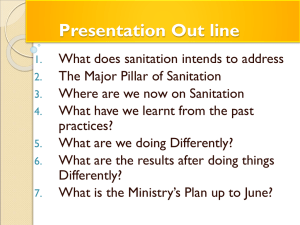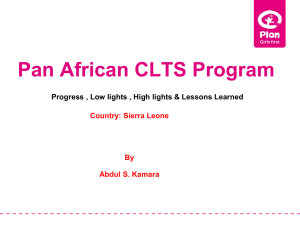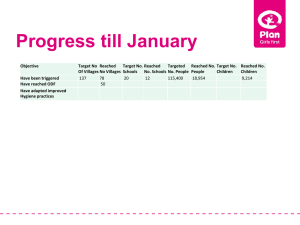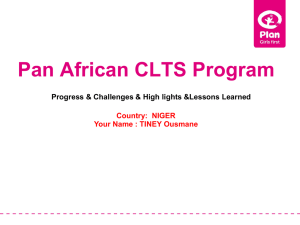Improved - Community-Led Total Sanitation
advertisement
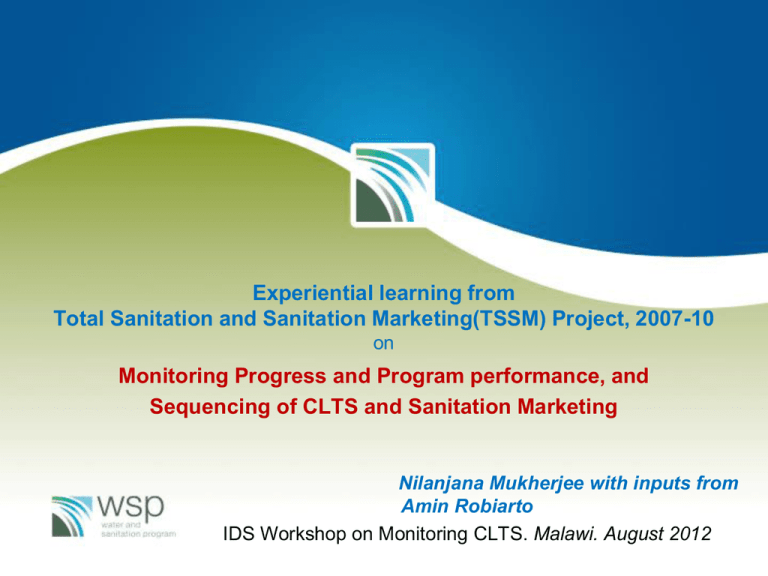
Experiential learning from Total Sanitation and Sanitation Marketing(TSSM) Project, 2007-10 on Monitoring Progress and Program performance, and Sequencing of CLTS and Sanitation Marketing Nilanjana Mukherjee with inputs from Amin Robiarto IDS Workshop on Monitoring CLTS. Malawi. August 2012 1. Monitoring progress in communities Experience from 29 districts in East Java during Scaling Up Rural Sanitation showed: Communities are able to monitor access to improved sanitation, and progress towards ODF achievement, in ways that satisfy JMP monitoring requirements. Key pre-condition – Establish and use locally relevant, commonly agreed definitions for Improved/unimproved sanitation and criteria for ODF status, which are easy to understand and communicate in local language. Examples of maps E. Java communities make and use for monitoring - households color coded by sanitation practice ( open defecators, sharers, users of improved/unimproved latrines) Examples of Improved latrines, by local definition Examples of Unimproved latrines, by local definition Community register- updated monthly from map Data picked up from community maps/registers by Health Extension worker – recorded in Primary Health Center format But, •Manual pick up and transfer of data to district often late. •When triggered communities ran into hundreds and thousands, manual monitoring data collection systems failed to keep up. Possible solution - Cell phone text messagebased reporting introduced in 2010 Data Base •Data more accurate •Quick data transfer •Resource-efficient • WSP-developed software installed in district Health Office computer gateway. • Auto-checks for validity of data received via text messages. • Only from phones registered with the gateway. DATA SOURCE # community households reported via phone text message every month. - Baseline report – one time - Monthly updates thereafter Improved Permanent Improved-semipermanent Sharing/unimproved Open defecator 0 5 1 75 Improved Permanent Improved-semipermanent Sharing/unimproved Open Defecator 21 13 10 41 ODF Verification guidelines providedFor use by sub-district agencies/Puskesmas Guidelines include: Definitions – Improved/Unimproved sanitation, ODF. Recommended community-level process Recommended composition of Verification team Checklist for household latrine observation Checklist for environmental observation Open Defecation Free Certificate presented to verified ODF community by District Government 2. Monitoring program performance Using monitoring data to improve program efficiency within districts District government have used it for: Identifying bottlenecks, high/low performing subdistricts Comparing outputs and outcomes from different program approaches (e.g.CLTS vs. other approaches) Advocacy with district legislatures for budget allocation for rural sanitation Household investment generated for improving sanitation access, using different program approaches (District Lumajang , East Java. 2007-08 ) 10 9.2 9 8 7 Household investment 6 generated for improving sanitation 5 access, per Rp 1 million program investment 4 (in millions rupiahs) 3 2 1 1.0 1.0 1.0 WSLIC2 Program "Gerbang Mas" Program Subsidies latrine PNPM/P2KP 0 CLTS-SToPS Program No. of new latrines built as result of each Rp 1 million program investment 40 No. of new latrines built as result of each Rp 1 million program investment from various approaches (District Lumajang, East Java , 2007-08 ) 37 35 30 25 20 15 10 5 3 2 1 - CLTS-SToPS Program Nov'07-Apr '08 WSLIC2 Program revolving credit "Gerbang Mas" Program -stimulant Subsidised latrine PNPM/P2KP Using monitoring data to improve program efficiency in province Province and national governments have used it for: Comparing program performance across districts Generating competition among districts – linking program outcomes to award ( annual Good Governance evaluation by JPIP Media Foundation) Annual Stakeholder Learning Reviews – publicizing cross-district performance data, generating learning analysis by district government personnel- sparking mutual support/sharing of knowledge and expertise from one district to others. Annual Average of Household Investments Leveraged per Rp. 1 million LG investment in 29 districts 2008-09-10. BOJONEGORO GRESIK MALANG TRENGGALEK MOJOKERTO PACITAN LUMAJANG MAGETAN LAMONGAN SAMPANG BLITAR PAMEKASAN PONOROGO PROBOLINGGO SITUBONDO JOMBANG NGANJUK NGAWI KEDIRI TULUNGAGUNG SUMENEP BANGKALAN JEMBER BONDOWOSO PASURUAN MADIUN SIDOARJO BANYUWANGI TUBAN 43 27 16 14 12 11 11 8 7.0 7 6 6 6 5 5 4.4 4 4 4 3 3 3 3 3 3 2 2 1 0 0 5 10 15 20 25 30 Household investment generated for improving sanitation access, per Rp. 1 million program investment (in million rupiahs) 35 40 45 50 Household Sanitation Access Gains in 29 districts per Rp.1 million program intervention (annual average from 2008-09-10) BOJONEGORO GRESIK MALANG TRENGGALEK MOJOKERTO PACITAN LUMAJANG MAGETAN LAMONGAN SAMPANG BLITAR PAMEKASAN PONOROGO PROBOLINGGO SITUBONDO JOMBANG NGANJUK NGAWI KEDIRI TULUNGAGUNG SUMENEP BANGKALAN JEMBER BONDOWOSO PASURUAN MADIUN SIDOARJO BANYUWANGI TUBAN 172 107 64 54 46 46 44 32 28.1 26 23 23 22 21 20 17.8 17 16 15 14 14 13 13 12 11 9 7 3 1 0 20 40 60 80 100 120 140 160 Annual average of additonal households gaining access to improved sanitation, per Rp. 1 million program investment 180 200 21 FINANCING: Local government budget for sanitation OUTCOME: Access increased per 1 million Investment 10 10 10 10 OUTCOME: Program investment by ODF Communities OUTCOME: % Access increas to Improved latrine DEMAND CREATION: number of triggered communityies 10 10 OUTCOME: Community investment per 1 million program investment FINANCING: % Local government sanitation budget For non-construction category 5 15 SUPPLY IMPROVEMENT: number of masons trained per sub-district which provide “WC-ku Sehat” 5 15 OUTCOME: Number of ODF commuities SUPPLY IMPROVEMENT: number of “WC-ku Sehat” vendor per subdistrict 22 3. Sequencing CLTS and Sanitation marketing interventions What we learned about sequencing CLTS and Sanitation Marketing in rural sanitation programs at scale It is critically important to invest in market research BEFORE creating demand (e.g.with CLTS and Behavior Change Communication) at large scale , because: Market research findings identify how best to move forward in scaling up so as to maximize program impact. Market research findings prevent funds being mis-allocated and wasted at scale. Sanitation marketing interventions at scale need 12-18 months’ preparation time. Start market research as early as possible in new projects. Lesson learned from TSSM implementation experience and research on Factors associated with achieving and sustaining ODF communities (WSP, 2011) See following examples………… 6 Rich Households Middle income households Poor Households 5 Rp.5-12 million 4 Rp.2-4 million 3 Rp.1 – 1.5 million 2 Rp.300,000 – 500,000 1 Rp.50,000– 300,0000 Labor + 0 cost OD WHO IS BUILDING WHAT- AT WHAT COST IN EAST JAVA 2008-2010. (WSP,2011) T5 T4 Concrete slab and ceramic pan T3 Concrete offset Slab T2 Concrete Slab with a lid 1 Wooden slab with a lid Bamboo clay-lined slab with a lid Missing option - Consumers want T5 technology, but at much lower than T5 cost – WSP Market Research (Nielsen,2009) Market research finding used by local sanitation entrepreneur to identify and develop missing options desired by consumers. His products are in very high demand Sumadi’s 1-page promotional flyer ” Informed Choice Catalogue for Affordable and Progressively Upgradable Healthy Latrine” WC TUMBUH SEHAT WC TMBUH se-Harga Rp. 180.000,1.Closed Keramik Duty 2.Dudukan closed 1 buah, aman dari kemancetan barang asing 3. Paralon 3 “ 1,5meter 1 buah Dalam waktu 2 tahun penampung peresapan penuh, dengan harapan sudah dapat membangun septictanknya. Ingat ” Kaedah Sanitasi Harus Tetap dipakai”. Hubungi . SUMADI,ST ( sanitasi Nganjuk)Hp. 081 335 265 157. . e-mail. sumadi_sakinem@yahoo.co.id. Masyarakat Menyiapkan galian dgn ukuran panjang dan lebar 1m kedalaman 75 cm sebagai penampungan peresapan. Artinya Penampungan peresapan tanggung Jawab masyarakat. Harga. Rp.600.000,Specifik material : 1.Closed Keramik Duty 2. Paralon 3 “ 4meter 1 buah 3. Paralon 2” 4 meter 1 buah 4. Buis beton 4buah dengan spesi , semen : pasir = 1: 5 5. Dudukan closed 1 buah, aman dari kemancetan barang asing 6. Slap deker 3 buah dengan besi bertulang 6 B. 7. Garan 4 tahun pemakaian untuk 5 orang/KK Pesanan minimal 10 unit untuk Kab. Nganjuk, Untuk Luar Nganjuk 20 Unit ditambah tranport kendaraan. Hubungi . SUMADI,ST ( sanitasi Nganjuk)Hp. 081 335 265 157. e-mail. sumadi_sakinem@yahoo.co.id. Masyarakat menyiapkan galian panjang dan lebar 130cm dalam 160 cm dan yang satu dalam 60 cm Harga. Rp.850.000,Specifik material : 1.Closed Keramik Duty 2. Paralon 3 “ 4meter 1 buah 3. Paralon 2” 4 meter 1 buah 4. Buis beton 7 buah dengan spesi , semen : pasir = 1: 5 5. Dudukan closed 1 buah, aman dari kemancetan barang asing 6.. Slap deker 5 buah dengan besi bertulang 6 B 7. Garan 8 tahun pemakaian untuk 6 orang/KK Pesanan minimal 4 unit untuk Kab. Nganjuk, Untuk Luar Nganjuk 10 Unit ditambah tranport kendaraan. Hubungi . SUMADI,ST ( sanitasi Nganjuk)Hp. 081 335 265 157. e-mail. sumadi_sakinem@yahoo.co.id. Masyarakat menyiapkan galian panjang 250cm, lebar 130cm dalam 160 cm dan yang satu dalam 60 cm Post-project action research in 20 districts : TSSM-trained masons found in only 9% sampled communities(all ODF). Rest gone to cities/abroad/ not serving rural consumers. Where trained entrepreneurs are present, they are providing, reduced-cost versions of what consumers want/aspire to, e.g. Pour-flush latrines at Rp.250,000 – 750,000 Offset pit latrines with lids at – Rp.59,000O Providing designs upgradable over next 1-2 years Offering installment payments terms of Rp 20,000 – 50,000 monthly Need to increase numbers of locally resident masons capable of serving poor customers in these ways. (WSP Action research, 2011) Need to intervene at enterpreneur level (higher than masons) for impact at scale (WSP market research, Nielsen, 2009) TSSM INFORMED CHOICE CATALOGUE–developed as a communication tool for masons to use with customers But –information tools on options, made available from TSSM, are NOT reaching rural consumers – copies lying in District/PHC offices. Action researchers showed, discussed and left behind the TSSM Informed Choice Catalogue (ICC) in 40 Not ODF communities…. Frequency of responses Never seen before: in 40 of 40 communties Interest expressed in the options: in 21 of 40 communities Action initiated immdtly with local mason to build 1 or more options from ICC : in 11of 40 communities No interest in the Dry pit options: in18 of 40 communities No interest in latrines (river OD-ers): in 4 of 40 communities (WSP, 2011) Recommendation : Make available informed-choice communication tools on market-research-based options in the hands of locally resident masons in communities !! THANK YOU !
